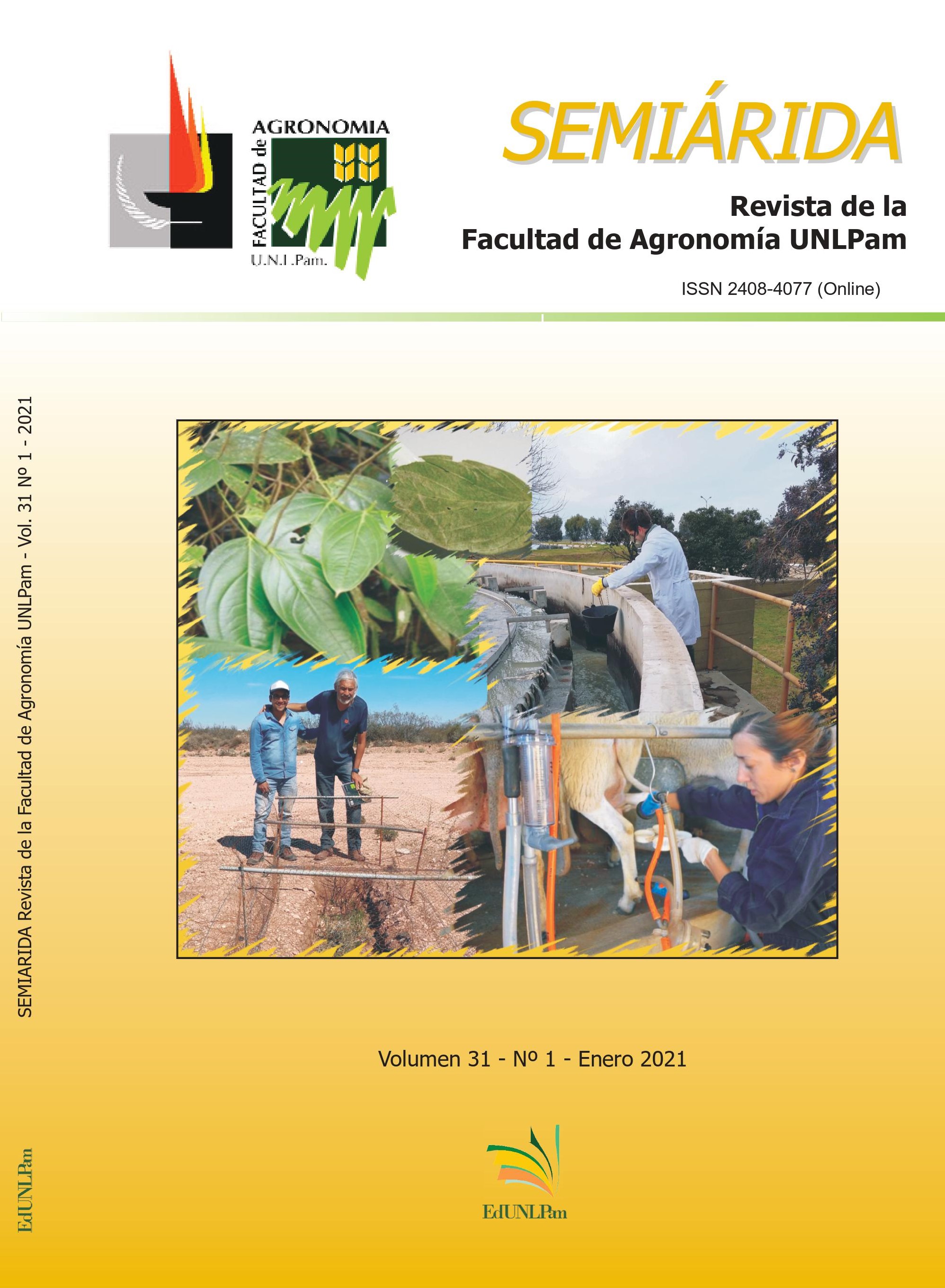Retention efficiency of the sewage treatment plant of Trenque Lauquen city (Buenos Aires)
DOI:
https://doi.org/10.19137/semiarida.2021(01).25-34Keywords:
total nitrogen; total phosphorus; nitrate; ammonia; phosphate; chlorophyll; winter; summer;Abstract
The Trenque Lauquen sewage treatment plant was created in 1992 when the population was substantially smaller. The objective was to determine its retention efficiency since its effluents could cause a strong negative impact on the environment. To evaluate the efficiency under extreme temperature conditions, samples of total suspended solids (TSS), chlorophyll, and total nitrogen (TN) and phosphorus (TP) were taken throughout the plant in winter and summer. The Imhoff well retained 2437 % TSS and always retained 100 % of the inorganic suspended solids. Although the plant retained between 1120 % TN and 1117 % TP, the plant discharge values (2341 mgNT/L and 3.94.1 mgPT/L) still exceed the law allowance. Variations in retention between contrasting seasons were mainly due to an increase in biological activity in summer. Retention efficiency could be improved by the use of phytoremediation, plant maintenance and expansion of existing facilities.
Downloads
References
APHA. (1992). Standard Method for the examination of water y wastewater, Edición 18, Washington D.C.1022 p.
Arar, E. J. & Collins, G. B. (1997). In vitro determinationof chlorophyll a and pheohitina in marine andfreshwater algae by fluorescence. Método EPA445 www.epa.gov/nerlcwww/ordmeth.htm
Chung, A. K. C., Wu, Y., Tam, N. F. Y. & Wong, M. H.(2008). Nitrogen and phosphate mass balance ina subsurface flow constructed wetland for treatingmunicipal wastewater. Ecological Engineering, 32,81-89.
Crespi, R., Plevich, O., Thuar, A., Grosso, L.,Rodríguez, C., Ramos, D., Barotto, O., Sartori, M.,Covinich, M. y Boehler, J. (2007). Manejo de aguas residuales urbanas. Universidad Nacional de Río Cuarto. Córdoba, Argentina. 23 p.
Crites, R. & Tchobanoglous, G. (2000). Tratamiento de aguas residuales en pequeñas poblaciones. McGraw Hill: Colombia. De Lora, F. & Miró, J. (1978). Tratamiento y depuración de aguas residuales. En F. De Lora & J. Miró (Eds.) Técnicas de defensa del medio ambiente(pp. 5679). Barcelona, España: Ed. Labor.
EPA. (1993). ESS Method 340.2: Total Suspended Solids, Mass Balance (Dried at 103–105 ˚;C)Volatile Suspended Solids (Ignited at 550˚;C). http://www.epa.gov/glnpo/lmmb/methods/methd340.pdf (14/09/2017)
EPA. (2004). Local limits Development Guidance. EPA833R04002A July 2004.EPA. (2008). Municipal Nutrient Removal TechnologiesReference Document. EPA 832R08006,September 2008.EPA. (2009). Nutrient control design manual.EPA/600/R09/012 January 2009.
FAO. (2016). Uso del agua.http://www.fao.org/nr/water/aquastat/countries_regions/Profile_segments/ARGWU_eng.stm(2/10/2017).
Gebremariam, S. Y. & Beutel, M. C. (2008). Nitrateremoval and DO levels in batch wetlandmesocosms: Cattail (Typhaspp.) versus bulrush(Scirpusspp.). Ecological Engineering, 34, 16.
Hammer, Ø., Harper, D. A. T. & Ryan, P. D. (2001).PAST: Paleontological Statistics Software Packagefor Education and Data Analysis. PalaeontologiaElectronica, 4(1), 9.INDEC. (2010). Censo Nacional de Población, Hogaresy Viviendas. www.censo2010.indec.gov.ar(8/08/2020).INTA. (2017). Sistema de Información y Gestión Agrometeorológico. http://siga2.inta.gov.ar/en/datosdiarios/ (19/19/2017).
Laws, E. A. (1993). Aquatic pollution. An introductorytext. New York: John Wiley & Sons.
Margalef, R. (1986). Ecología. Barcelona, España: Ed.Omega. OPS/CEPIS. (2005). Guía para el diseño de tanquessépticos, tanques Imhoff y lagunas de estabilización.OPS/CEPIS/05. 163. Lima Perú.
Ortega Sastriques, F. y Orellana Gallego, R. (2007). El riego con aguas de mala calidad en la agricultura urbana. Aspectos a considerar. II. Aguas residuales urbanas. Revista Ciencia Técnica OSN. (1973). Manual de laboratorio para técnicos sanitarios. Argentina.
Polanco, C. E. & Pilati, A. (2014). Retención de nitrógeno y fósforo en la planta de tratamiento cloacal sur, Santa Rosa, La Pampa. Libro Actas IV Congreso Pampeano del Agua (pp. 2331). Santa Rosa, La pampa, Argentina. Schulz, C. J. (1995). Agua y medio ambiente.COSYPRO Ltda. QuemúQuemú (L.P.). Wetzel, R. G. (2001). Limnology. Lake and riverecosystems. 3ra Edición. Academic Press.
Yousefi, Z. & A. MohseniBandpei. 2010. Nitrogen andphosphorus removal from wastewater bysubsurface wetland planted with Iris pseudacorus.Ecological Engineering, 36, 777782.Zar, J. H. (1999). Biostatistical Analysis. 4th ed.,PrenticeHall, Inc., Upper Saddle River, NJ.
Downloads
Published
Issue
Section
License
La Editorial de la Universidad Nacional de La Pampa (EdUNLPam) exigirá a los/as autores/as la firma del siguiente documento:
La EdUNLPam lleva a cabo la publicación del artículo: (Título del Artículo) en SEMIÁRIDA Rev.Fac.Agron UNLPam ISSN 2362-4337 (impresa) ISSN 2408-4077 (en línea), del cual el/los abajo firmantes son autores de una o más partes. En el mismo acto, el/los autores entregan exclusivamente a la EdUNLPam todos sus derechos protegidos por las leyes de propiedad intelectual que rigen en la Argentina para reproducir, publicar, editar, fijar, comunicar y transmitir públicamente en cualquier formato o medio impreso o electrónico, inclusive internet, el artículo enviado a publicación e incluirlo en índices o bases de datos nacionales e internacionales. A cambio, la EdUNLPam entrega a los autores la autorización para la publicación o reimpresión con ines académicos y educativos en cualquier libro o medio de divulgación, con la sola obligación de citar el artículo original publicado en la EdUNLPam. Cada autor acuerda en que el material provisto a la EdUNLPam es un trabajo original, que no ha sido impreso o publicado en cualquier otro medio con anterioridad y que no vulnera derechos de terceros. El Primer autor tendrá la posibilidad de leer y corregir el artículo ya editado como “prueba de galera”, pero si el autor no devolviera esas correcciones de la prueba de galera dentro del tiempo especificado, el proceso de producción y publicación podrá proseguir sin la aprobación del autor. El/los autor/es no recibirán compensación monetaria de la EdUNLPam por el uso del material contenido en este artículo y asumen la responsabilidad de las opiniones vertidas en él.










.png)



22.png)



.jpg)




.jpg)
